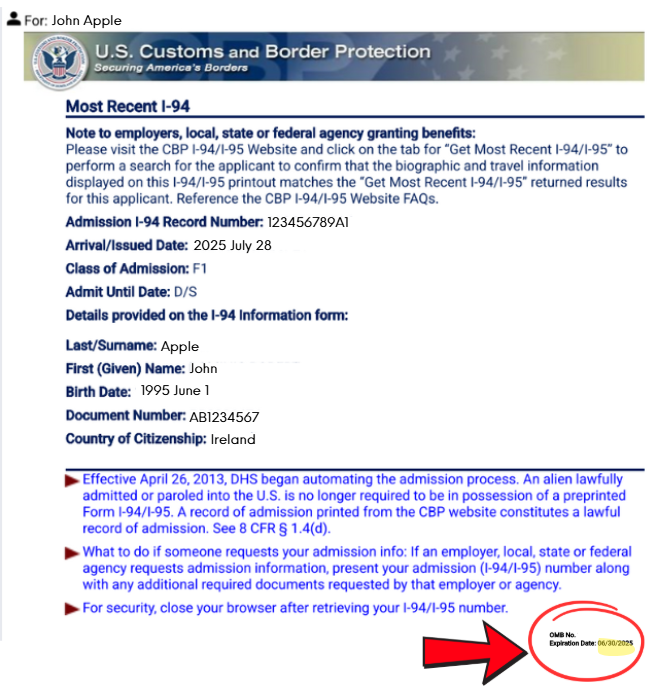A common point of confusion for nonimmigrants entering the country with a valid visa is the difference between their visa expiration date and their I-94 expiration date. Many nonimmigrants panic when they realize they need to file an I-94 extension before their visa expires, if they wish to remain in the country.
In this article, we’ll walk you through the process of extending your I-94 without leaving the country, elaborate on all the I-94 fees, and go over the key information about processing times.
What is An I-94 Extension?
An I-94 is an electronic record that shows the authorized period of stay of a nonimmigrant visa holder. Government agencies, employers, and immigration attorneys use the I-94 to verify a person’s lawful status and determine whether they are maintaining a legal stay in the U.S.
It’s important to be aware of your I-94’s expiration date so that you can plan when to file an I-94 extension, ideally well before your authorized stay expires.
Even though an individual may have a visa with a validity period of ten years, the I-94 specifies exactly how long a non-immigrant has to remain in the United States during their trip before they have to leave the U.S. or file an extension.
I-94 Arrival/Departure Record
Every non-immigrant entering the U.S. has an I-94, which records their arrival, visa status, and the length of time they are authorized to stay in the country. If the nonimmigrant is arriving through an airport, land, or seaport, then U.S. Customs and Border Protection (CBP) will create an electronic I-94 based on the travel records. Paper I-94 forms are no longer issued acording to the CBP.
The I-94’s duration varies per person, depending on the visa they are entering with. It can be valid for months or for the entire duration of the visa. If it is valid for the duration of the visa, then it is usually marked D/S for duration of status.
CBP will record your exit from the country electronically from the carrier’s manifest information if you are exiting from an airport, land, or seaport. You can check on the status of your I-94 at the CBP website.
Have questions about your I-94 record?
Who Qualifies for An I-94 Extension?
If your I-94 expiration date is before your visa validity date, you must file an I-94 extension while in the United States. However, not every nonimmigrant is eligible to apply for an extension.
To be eligible to request an extension of stay, an I-94 holder must meet the following conditions:
- You entered the United States lawfully with a valid nonimmigrant visa.
- You have not committed any act that would make you ineligible for a visa.
- You continue to maintain your current nonimmigrant status.
- Your passport is valid and will remain valid for the duration of your stay.
- You have not violated the terms or conditions of your admission.
Those with the following visas are NOT eligible for an extension:
- C visa, In Transit
- D visa, Crew member
- K-1 or K-2, Fiancé or Dependent of Fiancé
- S, Witness or Informant
- TWOV, Transit Without Visa
- WT or WB, Visa Waiver Program
I-94 Extensions for Students
F-1 student visa holders can extend their status by registering for more courses and getting an extended I-20 from the school. F-1 visa holders cannot change their status to a B-2 visa to finish their studies.
J-1 visa holders can request an extension by requesting a new DS-2019 from their sponsor to officially extend their status. Students can also request a change of status to a B-2 visa to finish up personal matters before they depart the U.S. However, they cannot continue to participate in their exchange program or any sort of program-related activities while on a B-2 visa.
You should file your I-94 extension at least 45 days before your current I-94 expires.
How To File For An I-94 Extension?
To file for an extension before your I-94 expiration date, one of the following forms must be filed:
- Form I-539, Application to Extend/Change Nonimmigrant Status. This is used to extend or change the status for non-employment-based categories
- Form I-129 Petition for a Nonimmigrant Worker. This is used to extend or change the status for employment-based categories and is filed by the employer.
Form I-539, Application to Extend/Change Nonimmigrant Status
Nonimmigrants with the following visas need to fill out and submit Form I-539 to request an extension:
- A-3
- B-1/B-2
- G-5
- H-4
- K-3, K-4
- L-2
- M
- N
- NATO-7
- O-3
- P-4
- R-2
- All V visas
- TD
For applicants without co-applicants/dependents who do not plan to use legal representation at any stage, our attorneys recommend filing online through the USCIS website.
In contrast, for applicants filing with dependents or applicants who may require legal representation at any point, it is advisable to file using the paper Form I-539. Paper filing has the added benefit of one payment fee for the whole family, as opposed to multiple payments required for each co-applicant when filing online. Importantly, each co-applicant included on your Form I-539 is required to fill out a separate Form I-539A.
In the form, you should be prepared to answer questions on the following topics:
- Basic information about you, such as your name, birth date, and U.S. address
- Your latest I-94 number, passport information, and date of last entry into the U.S.
- Your current visa category and its expiration date
- The number of people included in the application, if you are including a spouse or children
- Your new requested departure date
- Physical address abroad
- Any history of immigrant petitions
- Any criminal history
Attorney Tips
Questions in Part Four, “Additional Information About The Applicant,” contain questions about criminal history, status violations, and other grounds of inadmissibility. If you have any doubts about these, it is vital to contact a qualified immigration attorney, as answering yes or lying about any of the questions can complicate your case.
Additionally, to save time on your application, be prepared to provide evidence of your entire immigration history, not just your most recent status. At a minimum, have nearby your I-94 arrival/departure record, a copy of your passport, proof of relationship if applying as a family, and financial evidence proving you can support yourself if applicable.
I-94 Extension for Employment-Based Visa Holders
The I-94 extension process differs for employment-based visa holders; rather than applying yourself, your employer files Form I-129 Petition for a Nonimmigrant Worker on your behalf. These visa categories include:
- E-1, E-2 and E-3
- H-1B and H-1B1
- H-2A, H-2B, and H-3
- L-1A and L-1B
- O-1 and O-2
- P-1, P-2, P-3, P-1A, P-2S and P-3S
- Q-1
- R-1
- TN-1 and TN-2
You should be prepared to share details with your employer or a legal representative, including your personal and contract information, immigration status and history, and professional and educational information if applicable.
If you plan to live with your spouse and unmarried children under 21 years old in the United States, Form I-539 must be filed. One I-539 should be paper filed per family, and it should be filed together with the I-129.
Difference in Visa Expiration and I-94 Expiration Date
Understanding the difference between a visa expiration date and an I-94 expiration date is important to maintaining legal status in the U.S. The visa expiration indicates how long you can use your visa to enter the U.S., but the I-94 determines how long you can legally stay in the U.S.
Usually, I-94 expiration dates are issued at the discretion of the CBP officer. However, at VisaNation, we frequently see clients’ I-94 expiration dates limited by the expiration date of their passports.
For example, if your passport expires in 2027, but your visa is valid until 2028, the officer may issue an I-94 that expires in 2027. This means you would have to leave the U.S., renew your passport, and re-enter using your valid visa and obtain a new I-94, with an updated expiration date.
B-2 Tourist Visas
For many B-2 visas, they are typically valid for 10 years. However, the I-94’s for these visas typically have a 6 month validity period. If a CBP officer observed that the B-2 visa holder has been spending a lot of time in the U.S., they may issue an I-94 expiration date of 1 month.

I-94 Extension Documents
Every visa category requires different documents to be submitted with the I-539. Common documents include
- a copy of your I-94
- visa approval notices
- passport
- proof of address.
For a full list of documents required per visa category, visit the I-539 instruction sheet.
If your employer is filing an I-129 to extend your status, they must submit other documents, which depend on the employment-based visa you have. For a full list of requested documents for your specific visa category, visit the I-129 instruction sheet.
When applying for an I-94 extension, it is important to provide a valid and detailed reason for the request. VisaNation advises clients to include a statement in the extension application to explain why they are requesting additional time in the U.S. Within the statement, it should describe:
- The reason for the extension
- Why will the stay remain temporary
- The applicant’s plans to depart after the extended period
- How they plan to financially support themselves during the extended stay.
It is recommended to file the extension at least one month before your I-94 expires.
Sample I-94 Extension Request Letter
STATEMENT OF APPLICANT – ANNA KATERINA IVANOVA
I, Anna Katerina Ivanova, born on September 8, 1992, in Sofia, Bulgaria, and currently residing at 1550 N. Lake Shore Drive, Apt. 12C, Chicago, IL 60610, respectfully submit this affidavit in support of my Form I-539 application to request an extension of my B2 visitor status.
I entered the United States on a B2 visa to visit my sister, who is a U.S. citizen. My authorized stay is scheduled to end on November 30, 2025. Unfortunately, my sister underwent an unexpected and serious medical procedure last week, and she will require significant assistance and care at home during her recovery.
I am requesting an extension of my B2 status for an additional period of three months to care for my sister and support her family during this difficult time. Her doctor has advised she will not be fully mobile for at least 8-10 weeks. My presence is crucial for her post-operative care and to help manage her household, as her husband must return to work.
I assure you that I fully understand the temporary nature of a B2 visitor’s stay. I do not intend to overstay or violate any terms of my visa. My intention is solely to provide essential family support during this unforeseen medical emergency before returning to my home country.
I maintain a permanent residence and a full-time job in Bulgaria at the following address:
ul. “Tsar Ivan Asen II” 28, fl. 4 Sofia 1124, Bulgaria
Should you require any further information I am happy to provide it upon request.
Respectfully,
Anna Katerina Ivanova
I-94 Extension Fees
I-94 extension fees depend on what visa you hold, but fees start at $470. Below is a breakdown of fees.
- I-539: $470 (paper)/$420 (online)
- I-129: $1,015 (for employment-based visas). The extension fee is covered by the employer.
I-94 Extension Fee Tip
For the I-539, although the online filing fee is less expensive, a seperate fee must be paid for each c0-applicant. In contrast, paper filing only requires a single payment that covers the whole family.
I-94 Extension Processing Time
Processing times not only vary by service center but also by your visa category, with the fastest times being 2 months and the longest times up to 22 months. To check the average time, select I-539 or I-129 as the form and choose the appropriate service center.
Filing your I-94 extension does not guarantee that USCIS will grant the extension. Even if you file your I-94 extension on time, but your departure date arrives before USCIS can make a decision, you will not be deported until USCIS has decided on your extension. If your extension is later approved, then that period where you still resided in the U.S. while your extension was pending will be considered legal.
For many H cases, VisaNation observes that the I-94 expiration date accomodates a 10-day grace period. This means that we have noticed many of our clients on an H-1B visa having 10 additional days on their I-94 expiration date that extends past their H-1B visa expiration date.
If you file your I-539 online, you can check your status with the account you created. It is also important to periodically check that account in case USCIS has additional requests for evidence. If you file a paper version of the I-539, then USCIS will mail you a receipt with a tracking number for you to check the status of your application and an estimated processing time.
Common Requests for an I-94 Extension
- B-1/B-2 visa holders may request an extension if they have a legitimate personal or family reason that requires a longer stay in the U.S. For example, if a parent visits on a B-2 visa but needs to remain in the U.S. due to their child becoming sick, there was a death in the family, or a personal family reason, these can be explained in the statement to justify the extension.
- If an H-1B visa holder loses their job, they can change their status to a B-2 visa and request the I-94 extension. Most H-1B visa holders spent at least 5 years in the U.S., so they may own property, have cars, and other financial assets. This typically requires an extension to sort out their financial obligations before they can leave the U.S.
What is the i-94 extension processing time
The I-94 processing time depends on how long it takes USCIS to process the I-539 or I-129. The processing time is different for each visa category and processing center, and can range from as little as two months to as long as 22 months.
Can I file for an i-94 extension without leaving the country?
Yes, you can file for an I-94 without leaving the country. We recommend filing the extension at a minimum of 45 days before the expiration of your I-94.
What is the i94 fee?
The total cost of the I-94 for Form I-94 Arrival/Departure applications at land border ports of entry is $30. The i-94 price increased from 6$ on September 30, 2025.
I-94 extension costs depend on the visa classification. The I-539 application costs $470 (paper)/$420 (online), or for the I-129, $1,015 (for employment-based visas). The I-129 extension fee is covered by the employer.
How to get a i 94 extension for b1/b2
To get an extension for a B1/B2, you must either leave the country and return, or to extend without leaving, apply for an extension in the U.S. by filing form I-539. You must include a statement explaining in detail the reasons for your request, the reasons why your extended stay would be temporary, including what arrangements you have made to depart from
the United States, any effect the extended stay may have on your foreign employment or residency, and how you plan to financially support yourself while you are in the United States.










